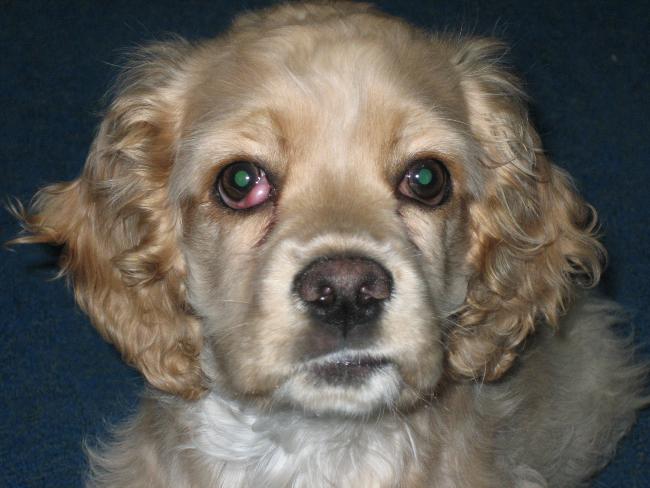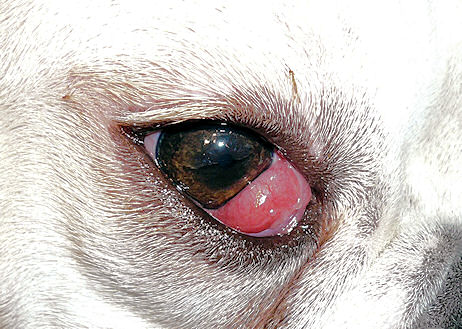Cherry Eye
(Prolapsed Gland Of The 3rd Eyelid)
Here's what you need to know (before talking to the vet)
if your Cocker Spaniel gets a cherry eye

Cherry Eye
|

|
Cherry eyes are fairly common in certain breeds of dogs... but probably more common in the Cocker Spaniel than any of the other breeds. Cherry eyes are a bit scary looking, and most owners freak out a little if their dog gets one. If you are not familiar with cherry eyes, you might tend to think that it's a tumor. Don't panic, though! A cherry eye is not a tremendously serious problem, and you might even be able to fix it yourself without even visiting the vet.
To bring you up to speed on cherry eyes, let's start with the basic information you need to know. Here's a close-up look at a dog with a cherry eye...

The pink flesh in the lower right corner of the left eye is a gland that is normally tucked under the eyelid. It has popped out from behind the eyelid and become visible. Normally it would be covered up by the eyelid in the lower right corner of the photo. Because the gland is pink, it looks a little bit like the dog has a sliced cherry stuck in the corner of his eye... thus the term cherry eye.
One very important thing to keep in mind is that a cherry
eye is mostly a cosmetic problem. There is no reason to get tremendously worried if your dog gets a cherry eye.
The dog's eyesight is not in danger, and the dog is in no pain. It just looks goofy to us humans. If a
cherry eye is left untreated, it increases the risk that the flesh will get infected, irritated or inflamed... or
that the dog will rub at it and damage his eye. Those are the
dangers involved, and (besides the cosmetic reasons) those are the reasons you would not want to leave a cherry eye
untreated.
What causes cherry eyes? It usually happens because the eyelid is a little loose, but sometimes happens in rough
play where a claw from another dog actually pulls the eyelid out a bit... or if the dog strains so much during
play that he forces the flesh out.
To help you understand cherry eyes a little better, it's time for a little analogy. If you're easily offended, you better stop reading right now, though!
A cherry eye (flesh pops out from behind the eyelid that
normally contains and conceals it) is very much like a breast popping out from behind a bra. It can happen for a
number of reasons... the breast is too big for the bra, the bra is too loose or mis-positioned around the breast,
or there is some brief unusual physical stress (imagine a mud wrestling match) that pops the breast out even though the
size of the breast and the bra are perfect matches.
So, if a breast pops out from behind a bra... what should be the first course of action? Rush to the plastic
surgeon for breast reduction surgery? No, I don't think so! The first thing to do is to use your fingers to
either pull the bra over the breast again or push the breast back in to the bra... whichever works best.
Then you wait and see if it stays in place after that. You also ask yourself some questions... why did this
happen? Is my bra the wrong size? Or was I just doing some unusual physical thing that created just the
right conditions to pop the breast out?
It's the same thing with cherry eyes in dogs. Don't rush to the vet for cherry eye surgery until you've tried the simple fix first. Wash your hands, and then use your fingers to gently manipulate the cherry eye back under the eyelid where it belongs. You can try pushing the eyelid over the protruding flesh... of pushing the flesh under the eyelid... whatever works best for you. Make sure you and the dog are both calm before you start doing this.
In most cases, you can massage a cherry eye back in to place. The question is... will it stay in place, or pop back out again? If it pops back out every time you massage it back in to place, or even if you can go a few days or weeks and then it just pops back out again... the dog is going to need some surgery to correct the problem. Either the eyelids are too loose, or the gland has become too large. One thing some vets try is prescribing eye drops to lower any swelling and inflammation in the gland. If the gland is inflamed, it won't stay under... but if you can get that inflammation down, maybe it will.
If the cherry eye occurred during rough play between two puppies, it most likely had nothing to do with the eyelid being too loose or the gland being too large... it just happened as a result of the rough play. Massage it back in place, and everything will be fine.
The good news is that in a fairly large percentage of cherry eye cases, simply massaging it back in to place will solve the problem. The bad news is that some vets either don't know this, or they don't bother telling you! I hate to think about all the dogs that have had cherry eye surgery over the years that might not have needed it.

Close-up photo of a dog with a cherry eye
Photo used under the terms of the Wikipedia GNU
Free Documentation License
If your dog does need surgery to repair a cherry eye, there are some very important things for you to know! In the old days, the standard technique for repairing a cherry eye was to simply remove the gland surgically. What they didn't know then was that this gland is responsible for tear production... and a lot of those dogs that had cherry eyes surgically removed ended up having dry eye problems after the surgery. The owner then either had to buy special eye drops for the dog and apply them every few hours for the rest of the dog's life, or risk damage to the eye from lack of moisture and lubrication. Sadly, even today, there are a few vets out there that still surgically remove the gland in order to fix a cherry eye. This should not happen!
It's been pretty well documented in the world of Veterinary Ophthalmology that the proper way to deal with a cherry eye is "surgical replacement", not "surgical removal". In a surgical replacement, the vet literally puts the gland back in place and secures it there. In surgical removal, the gland is cut out... and that's where the trouble with tear production starts.
(If you're not sure if you can believe some Cocker breeder in California, and you'd rather hear it from some experts in Veterinary Ophthalmology, check out what the American College Of Veterinary Ophthalmologists has to say about cherry eyes.)
The most common method for surgical replacement of a cherry eye is known as "the pocket technique". The vet creates a pocket behind the eyelid where the tear gland can be tucked away, the gland is put inside the pocket, and the pocket is sutured closed. Another common technique is to anchor the gland in place with a stitch to the back of the eye socket. With either of these methods, the gland remains intact and can continue to produce tears... but is held in place by a stitch so that it won't pop out again. If the vet is experienced in the technique and performs the operation correctly, it has an extremely high success rate. Of course, anchoring the gland down in one eye does nothing to prevent a cherry eye from occurring in the other eye some day! In fact, a dog with loose eyelids that gets a cherry eye in one eye is quite likely to have loose eyelids in the other eye and to get a cherry eye in that other eye, someday.
There's not necessarily a big advantage to visiting a Veterinary Ophthalmologist for cherry eye surgery. A lot of regular vets are very experienced at cherry eye repair, and can get the job done for tremendously less than a Veterinary Ophthalmologist will charge you. To determine if your regular vet is capable of doing the job properly, you should try asking a few simple questions. Does he recommend surgical removal of the gland, or does he recommend leaving the gland intact and anchoring it back where it belongs using a stitch? If he recommends removal of the gland, you can stop asking questions and just move on to another vet or a specialist... because that guy would be putting your dog at risk of dry eye problems for the rest of his life. He's woefully out-of-date in his training. If he recommends anchoring the gland back where it belongs, ask him how many times he has performed this surgery before, and what the success rate has been. If he tells you he's only done it a few times... I personally would be uncomfortable with that, and would try to find someone more experienced with the surgery. He's just learning. Also, if he quotes a success rate closer to 50% than 90%... he probably isn't real good at the technique. Try to find someone that says he has performed surgical repair (not removal) of cherry eyes a large number of times (more than 40?) and who says it is successful in the vast majority of cases. (80 or 90%)
If a dog has a cherry eye that requires surgery, this is generally a dog that should never be bred... as the physical conditions that created the cherry eye (loose eyelids, or too much flesh behind the eyelid) are likely to be passed on to the next generation. If a dog simply gets a cherry eye from rough play, and the cherry eye can be massaged back in to place, you don't need to worry about passing the cherry eyes on to the next generation... it was a fluke from rough play, not a genetic problem.
My experience with cherry eyes is that they tend to happen
the most to puppies, and that as the pups get older the eyelid tightens up and the chances of a cherry eye popping out
get lower over time. Puppies also play really hard and tend to build up the kind of forces that would be needed to force
the flesh out from behind the eyelid. As they get older, they don't play as hard and are therefore less likely to pop
out a cherry eye from simply straining extremely hard.
Some dogs have really loose eyelids, and they are going to be more prone to cherry eyes all their life. Back to the bra
thing... a woman who has set herself up with a properly fitted bra is at a very low risk of ever having a "wardrobe
malfunction", but you can never rule it out... especially as the body gets older and the size of the various parts
changes over time. The bra that is the perfect fit at 30 years old might not be the perfect fit at 40. The
point is that even an older
dog that has never had a cherry eye could get one someday.
There is a LOT more to this web site than just this page!
Please explore the rest of the site by viewing our table of contents,
or by clicking on one of the quick links below.
All About Our Cockers Meet Jim Zim Contact Jim Zim